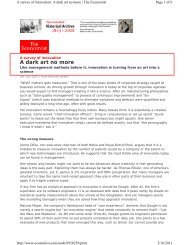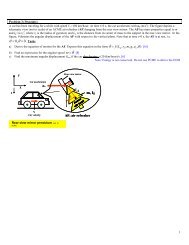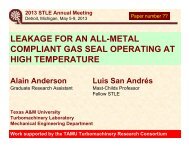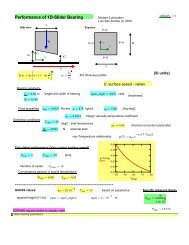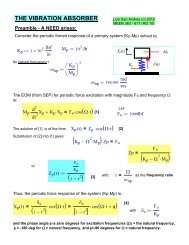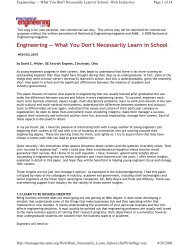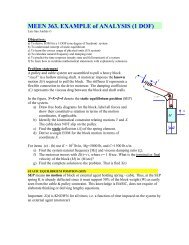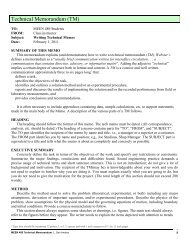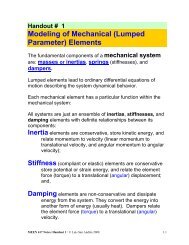TRC-SFD-1-07 - Tribology Group - Texas A&M University
TRC-SFD-1-07 - Tribology Group - Texas A&M University
TRC-SFD-1-07 - Tribology Group - Texas A&M University
Create successful ePaper yourself
Turn your PDF publications into a flip-book with our unique Google optimized e-Paper software.
Executive SummaryOpen end squeeze film dampers operating with low levels of pressurization are proneto air ingestion and entrapment that drastically reduce their damping capabilities. Endseals can significantly reduce the severity of air ingestion. A prior <strong>TRC</strong> report [3]advances an experimental work to identify the force coefficients of a combined squeezefilm damper and mechanical end seal. The test damper configuration includes outlet portsfor oil flow through the damper at the sealed end. The system parameters are identified ina two step procedure. First, the mechanical seal friction force is identified from circularorbits tests prior to pumping oil through the damper (i.e. dry system). Second, thesqueeze film force coefficients are extracted from the system force coefficients identifiedfrom circular orbit tests with oil circulating through the damper.This report extends the experimental work advanced in [3] to include theidentification of force coefficients for the same <strong>SFD</strong> damper but with closed outlet ports(i.e. no-thru flow). An identification method, suited for non-linear systems, allows tosimultaneously identify the squeeze film force coefficients and dry friction forceintroduced by the mechanical seal. The identification procedure shows similar (within10 %) damping and added mass coefficients than those reported for the thru-flowconfiguration. The oil temperature in the squeeze film land does not increase significantlydespite the no-thru flow condition. The oil temperature remains constant due to the shortlength of the experiments, the relatively small amount of energy (work) input into thesystem, and the large amount of oil stored in the <strong>SFD</strong> inlet plenum. In an actualapplication, the no-thru flow condition is expected to lead to an increase of the oiltemperature and a significant reduction of damping.In addition, tests are conducted to find the onset excitation amplitude and frequenciesleading to air ingestion. The results, for the maximum allowable shaker loads,demonstrate no evidence of oil cavitation in the damper land. On the other hand, for thelargest test amplitude (74 um at 50 Hz) and one of the highest test frequencies (32 um at100 Hz), the experiments indicate the ingestion of air into the <strong>SFD</strong> land. Visualobservations of the <strong>SFD</strong> land shows that, besides the seal interface, air is being ingestedthrough other passages including the juncture of the instrumentation facing the damperfilm land. The amount of air ingested is relatively small and the damper performance isnot greatly affected.2





